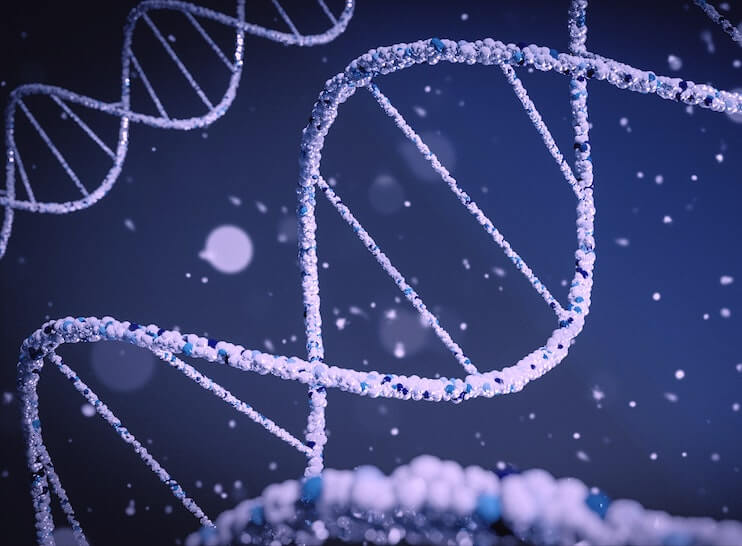Endometriosis is a condition in which cells similar to those lining the uterus grow in other body parts. It is fairly common, affecting 10% of women of reproductive age. In this article, we’ll explain what you need to know about endometriosis, including its symptoms, complications, causes, and who is most at risk.
{{mid-cta}}
What is Endometriosis?
During a woman’s menstrual cycle, hormones are released in the body that direct the lining of the uterus to thicken and then shed during their period. These growths are often on the ovaries, fallopian tubes, and tissues lining the pelvis. However, these cells can also grow in other parts of the body. Endometriosis tissue acts like the tissue lining the uterus, which responds to hormones, builds up, and then sheds during the menstrual cycle. However, it does not leave the body. Blood and tissue can accumulate in the body over time, exacerbating endometriosis symptoms as a woman ages.
The amount of endometriosis tissue within the body is not necessarily proportional to the severity of symptoms experienced. For example, women with large growths on many organs may have minor symptoms, while those with small growths may experience severe symptoms. Some people with endometriosis have no symptoms and are diagnosed only after being tested for infertility or other surgeries.
While endometriosis likely begins to develop once menstruation starts, symptoms likely won’t begin until many years later, and it is often not diagnosed until the late twenties to forties. Even when symptoms do arise, it can be difficult to diagnose in part because it can be confused with other conditions like pelvic inflammatory disease, ovarian cysts, or irritable bowel syndrome.
Risk Factors
You may be more likely to develop endometriosis if:
- You have a family member with the disease [endometriosis can be hereditary]
- Your menstrual cycle began at an early age
- You go through menopause at a late age
- You have never given birth
- You have short menstrual cycles (less than 27 days) or long periods (lasting seven days or more)
- You have a low body mass index
- You have high estrogen
- You have a condition of the reproductive tract or a condition that prevents blood flow out of the body
<p class="pro-tip"><strong>Also Read: </strong><a href="what-is-a-normal-insulin-level-for-a-woman">What Normal Insulin Levels for Women Look Like</a>.</p>
Symptoms

- Painful Periods: The most common symptom of endometriosis is pain in the pelvic area, especially during the menstrual cycle. While most women experience period cramping, those with endometriosis often experience more severe pain and cramping before and during their period.
- Excessive Bleeding: You may have very heavy periods or bleed between periods.
- Pain From Sex: Endometriosis commonly results in pain during or after sexual intercourse.
- Pain During Urination or Bowel Movements: This is most likely to occur before or during your period.
- Infertility: You may have trouble getting pregnant.
- Other Symptoms: You may also experience fatigue, diarrhea, constipation, bloating, or nausea. These symptoms are more likely to occur during your period.
Complications
In some cases, endometriosis can have long-term consequences. These may include:
- Infertility: The most common complication that results from endometriosis is trouble getting pregnant. Because endometrial tissue cannot leave the body when it sheds, it causes agitation as it builds up and can create scar tissue that blocks the fallopian tubes. The condition may also inhibit fertilization in other ways, like damaging the egg or sperm.
- Gestational Diabetes: Research has shown that women with endometriosis have a higher risk of developing gestational diabetes mellitus.1
- Obstruction of the Intestines or Urinary Tract: Though rare, endometrial tissue can cause blockages in the intestines or urinary tract.
- Ovarian Cysts: When the ovaries are affected by endometriosis, ovarian cysts called endometriomas may form. As a result, surrounding tissue can be agitated and form scar tissue. In some cases, cysts can rupture and cause pain.
- Cancer: Though rare, endometrial cells can become cancerous after menopause.
Causes
It is unclear exactly what causes endometriosis, but researchers and healthcare professionals believe that these factors may be possible causes:
- Retrograde Menstruation: This is when some menstrual fluid flows back through the fallopian tubes into the pelvis cavity instead of out of the body. When this happens, endometrial cells from the lining of the uterus are transported by the menstrual fluid into the pelvic cavity and can stick to the pelvic walls and organs. Once attached, they can grow and form endometrial tissue.
- Transformed Peritoneal Cells: Peritoneal cells line the inner side of the abdomen. Hormones or immune factors could transform these cells into endometrial cells resembling those lining the uterus.
- Transformed Stem Cells: Stem cells are at early stages of development and have not yet differentiated into specialized cells. Hormones like estrogen could transform these cells into endometrial cells at locations outside the uterus during puberty.
- Scar Tissue in the Stomach Area: Scar tissue from previous surgeries in the abdomen area could increase the likelihood of endometrial cells attaching to the site.
- Transport of Endometrial Cells: The circulatory or tissue fluid system could transport endometrial cells to other parts of the body.
- Microbiome Composition: Some research suggests that microbiota influences the development and decrease of endometrial tissue.2
- Immune System Dysfunction: Conditions of the immune system could inhibit the immune system’s ability to destroy endometrial cells in places they don’t usually grow.
The Link Between Endometriosis and Blood Sugar
Some evidence suggests that endometriosis is associated with metabolic syndrome.3 One reason for this correlation may be the effect blood sugar dysregulation can have on the immune system. The immune system is your body’s defense against cells in unwanted locations, so it is central in preventing abnormal cell growth like endometrial tissue. High blood sugar levels increase inflammation and put stress on the immune system, which makes it less effective.
Dramatic fluctuations in glucose levels can also take a toll on the immune system and sex hormone balance by causing the release of stress hormones. Similar to high glucose levels, cortisol weakens the immune system. Elevated cortisol can also decrease progesterone levels, which can contribute to infertility and menstrual irregularities.4
High insulin resulting from blood sugar dysregulation could also contribute to endometriosis. While endometrial cells produce more lactic acid than regular cells, excess insulin can increase this production even further.5 Lactic acid can prevent natural cell death and also helps to defend the cells against the immune system.6 High insulin can also increase the activity of an enzyme called aromatase, which converts androgens to estrogen. Estrogen can accelerate endometrial tissue growth.7
Managing Endometriosis
Medical treatment can help improve the symptoms of endometriosis. Treatment may involve medication to control hormone levels, pain medication, fertility treatment, or surgery to remove endometrial tissue.
Making lifestyle decisions that prioritize balancing blood sugar like exercising regularly and eating a healthy diet may also help to prevent or improve endometriosis symptoms by improving fertility, premenstrual syndrome, and the immune system.
Get Insight into Your Body’s Metabolic Signals With Signos
Blood glucose level is a key indicator of overall health and is significantly affected by our everyday choices. With the next generation of continuous glucose monitors and Signos’ expert guidance, you can incorporate changes into your nutrition and lifestyle based on real-time personalized blood glucose data. Learn about Signos’ science-backed approach to achieving better health, weight loss, and more. See how Signos works to pair continuous glucose monitoring, an all-in-one app experience, and expert advice to help you reach your health goals. Take a quick quiz to see if Signos is right for you.
<p class="pro-tip"><strong>Learn More: </strong><a href="loss-of-appetite-during-pregnancy">Appetite Loss During Pregnancy: Why It Occurs + How to Face It</a>.</p>
- Item 1
- Item 2
- item 3
Topics discussed in this article:
References
- Chadchan, S. B.; Cheng, M.; Parnell, L. A.; Yin, Y.; Schriefer, A.; Mysorekar, I. U.; Kommagani, R. Antibiotic Therapy with Metronidazole Reduces Endometriosis Disease Progression in Mice: A Potential Role for Gut Microbiota. Hum Reprod 2019, 34 (6), 1106–1116. https://doi.org/10.1093/humrep/dez041.
- Li, B.; Zhang, Y.; Zhang, L.; Zhang, L. Association between Endometriosis and Metabolic Syndrome: A Cross-Sectional Study Based on the National Health and Nutrition Examination Survey Data. Gynecol Endocrinol 2023, 39 (1), 2254844. https://doi.org/10.1080/09513590.2023.2254844.
- Long, Q.; Liu, X.; Qi, Q.; Guo, S.-W. Chronic Stress Accelerates the Development of Endometriosis in Mouse through Adrenergic Receptor Β2. Human Reproduction 2016, 31 (11), 2506–2519. https://doi.org/10.1093/humrep/dew237.
- CDC. Diabetes and Your Immune System. Centers for Disease Control and Prevention. https://www.cdc.gov/diabetes/library/features/diabetes_immune_system.html (accessed 2024-03-08).
- Endometriosis - Symptoms and causes. Mayo Clinic. https://www.mayoclinic.org/diseases-conditions/endometriosis/symptoms-causes/syc-20354656 (accessed 2024-03-05).
- Salmeri, N.; Li Piani, L.; Cavoretto, P. I.; Somigliana, E.; Viganò, P.; Candiani, M. Endometriosis Increases the Risk of Gestational Diabetes: A Meta-Analysis Stratified by Mode of Conception, Disease Localization and Severity. Sci Rep 2023, 13 (1), 8099. https://doi.org/10.1038/s41598-023-35236-y.
- Endometriosis: MedlinePlus enciclopedia médica. https://medlineplus.gov/spanish/ency/article/000915.htm (accessed 2024-03-06).
- Zheng, J.; Dai, Y.; Lin, X.; Huang, Q.; Shi, L.; Jin, X.; Liu, N.; Zhou, F.; Zhang, S. Hypoxia‑induced Lactate Dehydrogenase A Protects Cells from Apoptosis in Endometriosis. Mol Med Rep 2021, 24 (3), 637. https://doi.org/10.3892/mmr.2021.12276.
- Esposito, K.; Nappo, F.; Marfella, R.; Giugliano, G.; Giugliano, F.; Ciotola, M.; Quagliaro, L.; Ceriello, A.; Giugliano, D. Inflammatory Cytokine Concentrations Are Acutely Increased by Hyperglycemia in Humans: Role of Oxidative Stress. Circulation 2002, 106 (16), 2067–2072. https://doi.org/10.1161/01.cir.0000034509.14906.ae.
- Berhane, F.; Fite, A.; Daboul, N.; Al-Janabi, W.; Msallaty, Z.; Caruso, M.; Lewis, M. K.; Yi, Z.; Diamond, M. P.; Abou-Samra, A.-B.; Seyoum, B. Plasma Lactate Levels Increase during Hyperinsulinemic Euglycemic Clamp and Oral Glucose Tolerance Test. J Diabetes Res 2015, 2015, 102054. https://doi.org/10.1155/2015/102054.
- Randolph, J. F.; Kipersztok, S.; Ayers, J. W. T.; Ansbacher, R.; Peegel, H.; Menon, K. M. J. The Effect of Insulin on Aromatase Activity in Isolated Human Endometrial Glands and Stroma. American Journal of Obstetrics and Gynecology 1987, 157 (6), 1534–1539. https://doi.org/10.1016/S0002-9378(87)80258-2.
- Berbudi, A.; Rahmadika, N.; Tjahjadi, A. I.; Ruslami, R. Type 2 Diabetes and Its Impact on the Immune System. Curr Diabetes Rev 2020, 16 (5), 442–449. https://doi.org/10.2174/1573399815666191024085838.
- What are the symptoms of endometriosis? | NICHD - Eunice Kennedy Shriver National Institute of Child Health and Human Development. https://www.nichd.nih.gov/health/topics/endometri/conditioninfo/symptoms (accessed 2024-03-08).
- What is Endometriosis? | Signs, Symptoms and Causes. https://www.plannedparenthood.org/learn/health-and-wellness/endometriosis (accessed 2024-03-07).


.jpg)





























